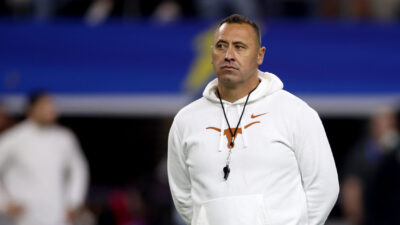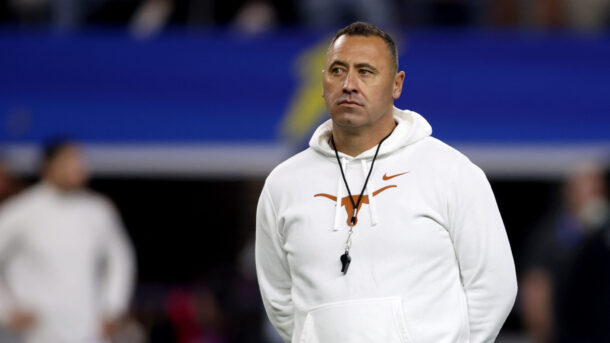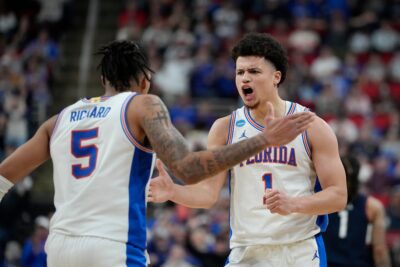Ad Disclosure
Where were you when MJ shot down Georgetown? Or when Lorenzo Charles stunned Houston by dunking in Dereck Whittenburg’s air ball?
Or was it a pass?
Are you old enough to remember the matchup that helped put the Madness into March, the first of many epic showdowns between Magic and Bird?
What about the night in 1957 when North Carolina became a giant killer rather than the giant itself?
They are just a few of the memorable championship games that have been played since the NCAA Tournament came into existence in 1939.
Here’s a look back at the best of the best:
Top 10 March Madness Championship Games
The criteria used to compile this subjective list include the quality of matchups, competitiveness of the games, dramatic finishes, stature of the players involved. Consideration was also given to the historical significance of the games and their results.
10. Duke 61, Butler 59, 2010
Playing in Indianapolis, only a few miles from its home gym – the same Hinkle Field House in which the movie Hoosiers was filmed, Butler came tantalizingly close to pulling off its own improbable Cinderella story. Seeded No. 5 in the West Region, the Horizon League champions put together an amazing run to battle their way into the national championship game against the ultimate blue-blood, Duke.
And with just 3 seconds remaining, the Bulldogs’ best player had the ball in his hands with a chance at victory after the Blue Devils’ Brian Zoubek intentionally missed the second of 2 free throws. Gordon Hayward, freed from a bone-crushing screen from Matt Howard, launched a buzzer-beating halfcourt shot that was dead on target. But it was a little too strong. It hit the backboard, then the front of the rim before falling out to end the game and spoil the Hollywood ending.
Kyle Singler led Duke with 19 points in helping Mike Krzyzewski to the fourth of his 5 national titles. Coach K’s eventual successor, current Blue Devils’ coach, Jon Scheyer, had 15 points, 6 rebounds, 5 assists and 2 blocked shots in the victory.
9. Villanova 77, North Carolina 74, 2016
The back-and-forth battle between the Wildcats and Tar Heels at Houston’s NRG Stadium came down to 2 decisive shots at the end.
One by each team.
The first was a remarkable circus shot by UNC’s Marcus Paige, a desperation, double-clutching 3-pointer that tied the score at 74 with 4.7 seconds remaining. Had the Tar Heels gone on to win the game in overtime, Paige’s shot would likely have been held in as high a regard as Michael Jordan’s championship-clinching jumper against Georgetown 34 years earlier. It certainly was more difficult.
But that didn’t happen. After a timeout, Villanova’s Ryan Arcidiacono rushed the ball up court before passing to teammate Kris Jenkins, who created his own “One Shining Moment” by sinking a game-winning 3-pointer as time expired.
It was the first buzzer-beater to win a national title since Lorenzo Charles did it for NC State in 1983. And there’s a twist. Jenkins is the adopted brother of UNC guard Nate Britt. One year and one day later, Jenkins was in the stands at Arizona’s University of Phoenix Stadium cheering Britt on as he and the Tar Heels beat Gonzaga to win a title of their own.
8. Florida 65, Houston 63, 2025
The game was the ultimate contrast of style. The Gators were the third-highest-scoring team in the nation, averaging 85 points. The Cougars led the nation in scoring defense, allowing only 58 points per game.
Whichever team imposed its will and style on the other figured to come out the winner and become champions. Only it didn’t work out that way. The game at San Antonio’s Alamodome played out exactly as Kelvin Sampson and Houston wanted. It was gritty. It was physical. It was slow-paced.
The Cougars held Florida to 20 points below their season average, dominated the offensive glass and held the Gators’ leading scorer, Walter Clayton Jr.’ without a field goal for the first 32 minutes. And yet, Todd Golden’s SEC champions still found a way to persevere. Fittingly, they did it with defense.
Although Will Richard’s 18 points kept the Gators close until Most Outstanding Player Clayton finally got going to lead his team on its fourth epic second-half rally in 6 NCAA Tournament wins, Florida won the title and made Golden the youngest national championship coach ever by holding Houston scoreless for the final 2:20 and forcing a decisive turnover on the game’s final possession.
7. North Carolina 77, Michigan 71, 1993
The matchup between Dean Smith’s disciplined, fundamentally sound Tar Heels and the Wolverines’ brash Fab Five was a classic clash of cultures. It was also a rematch of an earlier meeting in which Michigan beat UNC 79-78 on a late Jalen Rose basket in the semifinals of the Rainbow Classic in Hawaii.
The rematch in New Orleans also went right down to the wire.
The Tar Heels used a late 9-0 run, punctuated by an Eric Montross dunk, to take the lead with just under a minute remaining. But when Pat Sullivan missed the back end of a 1-and-1 with 19 seconds to play, it left the door open for Michigan to tie or win with a 3-pointer. But the Wolverines never took a shot.
After getting away with a travel in the backcourt, Wolverines’ star Chris Webber got trapped in a corner near his team’s bench by a pair of UNC defenders. Desperate and in danger of stepping out of bounds, Webber called timeout. Michigan didn’t have any left, resulting in a technical foul that all but decided the game.
The championship game loss, later vacated because of NCAA violations, was the second in as many years for Michigan’s Fab Five, who fell to Duke in 1992.
6. Michigan State 75, Indiana State 64, 1979
Though the game itself didn’t live up to the hype that preceded it, the interest generated by the matchup between the Spartans and Sycamores – or more accurately, between stars Magic Johnson and Larry Bird – is credited with popularizing the NCAA Tournament. Television ratings for the NBC broadcast were the highest for any game in basketball history to that time.
Bird was the best player in the country, averaging 30 points and 13 rebounds per game while Johnson was the nation’s most exciting player, a 6-8 blend of talent and showmanship. They would go on to form a rivalry that carried over to their NBA careers and made them the 2 most recognizable athletes in America.
While Indiana State came into the championship undefeated and ranked No. 1, Michigan State was the better team because Johnson was surrounded by a better supporting cast. The Spartans did their best to deny Bird the ball, challenging his teammates to beat them. They couldn’t. Though Bird finished with 19 points, he was just 7-of-21 from the floor. Johnson, meanwhile, scored 24 points to lead his team to the victory.
5. North Carolina 63, Georgetown 62, 1982
UNC’s Dean Smith was already fighting the perception that he couldn’t “win the big one” after losing his 3 previous trips to the national championship game. So the pressure was on against Georgetown and its All-American center Patrick Ewing.
Unintimidated by the 7-foot freshman, James Worthy and the Tar Heels took it right to Ewing, who was called for goaltending 5 times. The game between the nation’s 2 best teams, with their star-studded lineups, lived up to its hype. Neither team led by more than 4 points in the second half.
The Hoyas led by 1 with time running out when Smith called timeout to set up a play. UNC point guard Jimmy Black then found freshman Michael Jordan open along the left wing. Jordan was only the team’s third option, behind Tournament MOP James Worthy and Sam Perkins. But he calmly sank a 16-foot jumper with 15 seconds remaining to put the Tar Heels ahead.
And a legend was born.
Although everyone remembers Jordan’s go-ahead basket, it’s often forgotten that it didn’t clinch the championship. It wasn’t until Georgetown’s Fred Brown panicked and threw the ball right into the hands of a surprised Worthy that Smith finally got the monkey off his back and the celebration could begin.
4. Texas Western 72, Kentucky 65, 1966
The matchup at Maryland’s Cole Field House was historic. Upstart Texas Western (now known as UTEP), was the first team in championship game history to start 5 Black players. Kentucky wasn’t just a traditional blue-blood, but its Hall of Fame coach Adolph Rupp was among the last to embrace – reluctantly, at that – integration.
It’s a narrative recreated in the 2006 movie Glory Road.
Motivated by Rupp’s statement that his all-white Wildcats could not be beaten by an opponent with an all-Black lineup, the Miners of coach Don Haskins took the lead 3 minutes into the game and never trailed again.
Led by 20 points from star Bobby Joe Hill, 16 from Dave Lattin and 15 by Orsten Artis, Texas Western (28-1) cruised to a victory that didn’t just earn it the national championship. It also changed the face of college basketball by inspiring other programs all across the country to begin integrating their rosters.
3. Villanova 66, Georgetown 64, 1985
Two years after NC State’s improbable national championship, Rollie Massimino and his Villanova Wildcats upstaged the Wolfpack’s accomplishment by putting together an even more remarkable and unexpected title run.
The Wildcats were squarely on the NCAA bubble after going just 5-5 in their final 10 regular-season games and losing by 15 to St. John’s in the Big East Tournament semifinals to finish at 19-10. Even after getting into the field as a No. 8-seed, they barely scraped by winning their first 3 NCAA matchups by a combined total of 9 points before picking up momentum heading into the championship game against Big East rival Georgetown for the title.
Commentators suggested that it would take “the perfect game” for Villanova to pull off the biggest upset in March Madness championship history by beating Patrick Ewing and the defending national champions. A team they lost to twice during the regular season. But that’s what they did. With Most Outstanding Player Ed Pinckney leading the way, the Wildcats shot 78.6% from the floor, the highest percentage in Final Four history, and scored on all but 1 of their second half field goal attempts to stun the Hoyas 66-64.
2. NC State 54, Houston 52, 1983
On the eve of NC State’s national championship date with top-ranked Houston, columnist Dave Kindred mockingly wrote that trees would tap dance and elephants would drive in the Indy 500 before the 10-loss Wolfpack could find a way to beat the top-ranked Cougars. They’re words history tells us Kindred lived to regret.
You’ve heard the story by now.
After winning the ACC Tournament just to earn its NCAA bid, the “Cardiac Pack” ran through a gauntlet of elite teams and Hall of Fame opponents – Ralph Sampson, Michael Jordan and Hakeem Olajuwon among them – to reel off 9 straight wins and cut down the nets in Albuquerque, New Mexico, as one of the most improbable national champions in college basketball history.
Their 54-52 upset of heavily favored Houston in the final, secured on Lorenzo Charles’ dramatic last-second dunk of a Dereck Whittenburg air ball (or pass, depending on who you listen to) is still considered one of the top 2 upsets in March Madness history. The images of coach Jim Valvano frantically running around the court looking amid the wild celebration and his celebratory hug with Whittenburg are among the most iconic in all sports.
1. North Carolina 54, Kansas 53 (3OT), 1957
The Tar Heels are a college basketball goliath now. But in 1957, they were the upstarts hoping to slay Kansas and their giant star Wilt Chamberlain. UNC coach Frank McGuire tried to play mind games with the Jayhawks’ dominant 7-1 center by having 5-11 guard Tommy Kearns take the opening tap against him. The collapsing zone McGuire used to surround and frustrate Chamberlain was a much more effective strategy.
Even though Chamberlain still led all scorers with 23 points, UNC did a good enough job on him to hold the score down and send the game into overtime tied at 46. Kansas shot just 32% for the game. Despite playing 3 overtimes in a semifinal win against Michigan State 2 nights earlier and their own star Lennie Rosenbluth fouling out late in regulation, the Tar Heels persevered.
“Our plans for the game went as we expected them, with a collapsing defense against Kansas’ great player, Chamberlain,” McGuire told the Associated Press after the game. “We thought it worked very well. We feel very fortunate. … It was really remarkable that we won with Lennie Rosenbluth on the bench, since he was our key man all season.”
With Rosenbluth on the bench, teammate Joe Quigg stepped up to help UNC erase a late 5-point deficit in regulation. He then hit 2 free throws with 6 seconds left in the final overtime to clinch a perfect 32-0 season and the Tar Heels’ first national championship.
Award-winning columnist Brett Friedlander has covered the ACC and college basketball since the 1980s.



